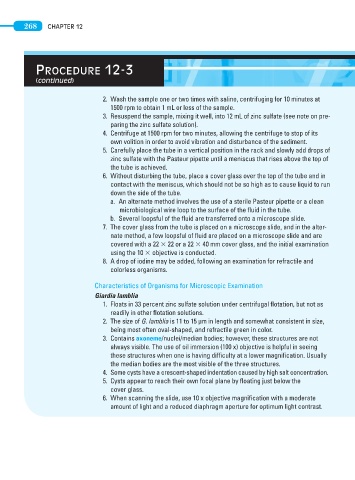Page 288 - parasitology for medical and clinical laboratoryprofessionals
P. 288
268 CHAPTER 12
PROCEDURE 12-3
(continued)
2. Wash the sample one or two times with saline, centrifuging for 10 minutes at
1500 rpm to obtain 1 mL or less of the sample.
3. Resuspend the sample, mixing it well, into 12 mL of zinc sulfate (see note on pre-
paring the zinc sulfate solution).
4. Centrifuge at 1500 rpm for two minutes, allowing the centrifuge to stop of its
own volition in order to avoid vibration and disturbance of the sediment.
5. Carefully place the tube in a vertical position in the rack and slowly add drops of
zinc sulfate with the Pasteur pipette until a meniscus that rises above the top of
the tube is achieved.
6. Without disturbing the tube, place a cover glass over the top of the tube and in
contact with the meniscus, which should not be so high as to cause liquid to run
down the side of the tube.
a. An alternate method involves the use of a sterile Pasteur pipette or a clean
microbiological wire loop to the surface of the fluid in the tube.
b. Several loopsful of the fluid are transferred onto a microscope slide.
7. The cover glass from the tube is placed on a microscope slide, and in the alter-
nate method, a few loopsful of fluid are placed on a microscope slide and are
covered with a 22 3 22 or a 22 3 40 mm cover glass, and the initial examination
using the 10 3 objective is conducted.
8. A drop of iodine may be added, following an examination for refractile and
colorless organisms.
Characteristics of Organisms for Microscopic Examination
Giardia lamblia
1. Floats in 33 percent zinc sulfate solution under centrifugal flotation, but not as
readily in other flotation solutions.
2. The size of G. lamblia is 11 to 15 μm in length and somewhat consistent in size,
being most often oval-shaped, and refractile green in color.
3. Contains axoneme/nuclei/median bodies; however, these structures are not
always visible. The use of oil immersion (100 x) objective is helpful in seeing
these structures when one is having difficulty at a lower magnification. Usually
the median bodies are the most visible of the three structures.
4. Some cysts have a crescent-shaped indentation caused by high salt concentration.
5. Cysts appear to reach their own focal plane by floating just below the
cover glass.
6. When scanning the slide, use 10 x objective magnification with a moderate
amount of light and a reduced diaphragm aperture for optimum light contrast.

